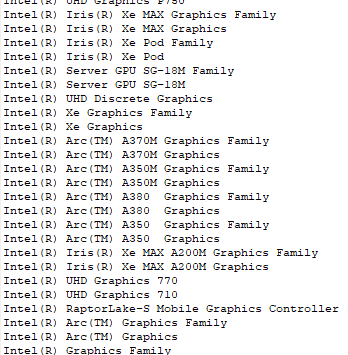Intel's Arc Alchemist Model List Leaks
Intel is about to start shipments of its new Arc discrete graphics processors based on the Xe-HPG architecture to notebook makers, so it's no surprise that details about the new family of GPUs continues to leak. Over the past few months, we've heard about numerous new Arc Alchemist GPU offerings from Intel, but it looks like there are still some surprises incoming.
Previous leaks indicated that Intel assigned as many as 32 PCI IDs for its Arc Alchemist devices designed for desktops and laptops. Now, a newly leaked list of GPUs supported by Intel's drivers sheds some additional light on the first wave of Intel's upcoming graphics product family. The leak comes from @momomo_us, who monitors hardware makers' websites (either using appropriate software or a private crawler), so the list probably comes from a driver (and not from, say, a Linux patch) that a company has uploaded to its website ahead of Intel's Arc-based products launch.
Assuming that we are indeed dealing with a driver supporting the following GPUs, this gives us a very rough understanding of what the first wave of Intel's DG2 products will look like.
The list of Arc-branded products includes the Arc A380 (a 128 EU part previewed a couple of weeks ago), Arc A350, Arc A370M, Arc A350M, and Iris Xe Max A200M graphics families. Since Intel intends to start the Arc/DG2 rollout of discrete graphics processing units from mobile parts in Q1, it's not surprising that the list mostly includes 'M' offerings as well as Arc A380/A350 for desktops. While we cannot state that for sure, it looks like some non-M Arc 300-series parts will be used for OEM desktop PCs due in late Q1 or Q2, hence they are already supported by drivers.
A particularly interesting GPU trademark is the Iris Xe Max A200M. This moniker will likely be used for Intel Alder Lake-based notebooks equipped with lower-end standalone DG2 parts that will be used by creative professionals for things like video encoding and other workloads that leverage GPU-accelerated computing (e.g., Adobe's Photoshop, After Effects, Premiere Pro, etc.).
These parts are not expected to offer serious graphics performance, so using Arc with them might harm the new brand, which might be why we see Xe Max branding instead. Again, since Intel is yet to formally announce all the details about its DG2 GPU branding, we can only speculate about the Arc Alchemist peculiarities.
As reported previously, Intel's DG2 family includes two standalone GPUs: a small one and a big one. The small one is what will be released this quarter, whereas the second one — which will be used for high-performance discrete desktop graphics cards — is scheduled to arrive in Q2.
Get Tom's Hardware's best news and in-depth reviews, straight to your inbox.

Anton Shilov is a contributing writer at Tom’s Hardware. Over the past couple of decades, he has covered everything from CPUs and GPUs to supercomputers and from modern process technologies and latest fab tools to high-tech industry trends.
